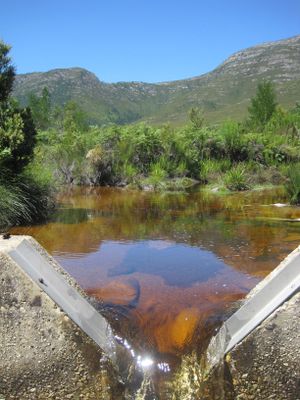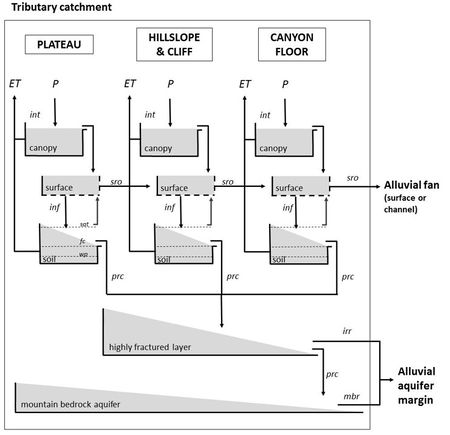Difference between revisions of "Main Page"
m |
|||
| Line 1: | Line 1: | ||
| − | [[File:Kouga_weir_resize.JPG|alt=|left| | + | [[File:Kouga_weir_resize.JPG|alt=|left|thumb|Weir on the Wabooms River, Eastern Cape]] |
==='''<big>Welcome!</big>'''=== | ==='''<big>Welcome!</big>'''=== | ||
'''This wiki site was built to provide guidance for people working on hydrological modelling projects in South Africa, with a focus on catchment-scale modelling.''' | '''This wiki site was built to provide guidance for people working on hydrological modelling projects in South Africa, with a focus on catchment-scale modelling.''' | ||
| − | + | ||
| Line 10: | Line 10: | ||
This wiki is a living resource: there are discussion pages and the user community can suggest updates. A moderator group will review content changes. | This wiki is a living resource: there are discussion pages and the user community can suggest updates. A moderator group will review content changes. | ||
| − | |||
| − | |||
| − | |||
| − | The idea for this site came from a group of early-career hydrologists facing many tricky modelling decisions in their research and projects. The Water Research Commission (WRC) funded the initial development of the material through the “Critical catchment model inter-comparison and model use guidance development” project (2019-2021). More information and reports from that project are found [[Model inter-comparison study (2020-21)|here]]. | + | [[File:Conceptual_model_diagram_bucket_style.jpg|alt=|450x450px|thumb|Example conceptual model diagram (Glenday, 2015)]]The idea for this site came from a group of early-career hydrologists facing many tricky modelling decisions in their research and projects. The Water Research Commission (WRC) funded the initial development of the material through the “Critical catchment model inter-comparison and model use guidance development” project (2019-2021). More information and reports from that project are found [[Model inter-comparison study (2020-21)|here]]. |
This project included a review of the structures and use experience across several commonly used modelling tools in South Africa: | This project included a review of the structures and use experience across several commonly used modelling tools in South Africa: | ||
| Line 27: | Line 24: | ||
| − | This wiki addresses many general issues in catchment hydrological modelling with a particular focus on the tools given above. These tools represent a variety of modelling approaches, however there are many models out there with a variety of different capabilities. Modelling tools change over time, with updates and improvements in new versions, and new tools are constantly being developed. With your help this wiki site will adapt to the needs and developments in the South African modelling community. | + | This wiki addresses many general issues in catchment hydrological modelling with a particular focus on the tools given above. These tools represent a variety of modelling approaches, however there are many models out there with a variety of different capabilities. Modelling tools change over time, with updates and improvements in new versions, and new tools are constantly being developed. With your help this wiki site will adapt to the needs and developments in the South African modelling community.[[File:Modelled_vs_observed_flow_demo.jpg|alt=|left|450x450px|thumb|Modelled vs observed streamflow]] |
Revision as of 09:48, 24 April 2021
Welcome!
This wiki site was built to provide guidance for people working on hydrological modelling projects in South Africa, with a focus on catchment-scale modelling.
Catchment modelling entails a lot of decision-making, from how many and which land cover types to include in a model, to which modelling software tool to use for a project. The goal of this site is to assist people in making informed decisions in this process and contribute to the ‘wise-use’ of modelling for the benefit of water resources management. You can find more details about the scope of this wiki here.
This wiki is a living resource: there are discussion pages and the user community can suggest updates. A moderator group will review content changes.
The idea for this site came from a group of early-career hydrologists facing many tricky modelling decisions in their research and projects. The Water Research Commission (WRC) funded the initial development of the material through the “Critical catchment model inter-comparison and model use guidance development” project (2019-2021). More information and reports from that project are found here.
This project included a review of the structures and use experience across several commonly used modelling tools in South Africa:
- Pitman, including WRSM-Pitman & SPATSIM-Pitman
- ACRU
- SWAT
- MIKE-SHE
This wiki addresses many general issues in catchment hydrological modelling with a particular focus on the tools given above. These tools represent a variety of modelling approaches, however there are many models out there with a variety of different capabilities. Modelling tools change over time, with updates and improvements in new versions, and new tools are constantly being developed. With your help this wiki site will adapt to the needs and developments in the South African modelling community.


